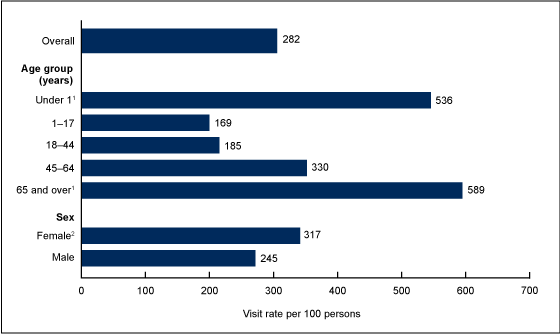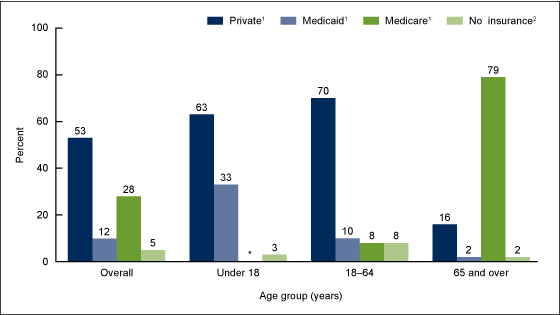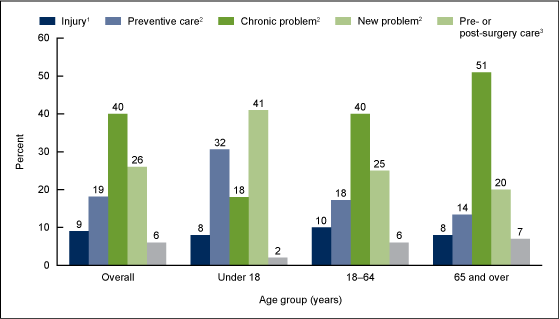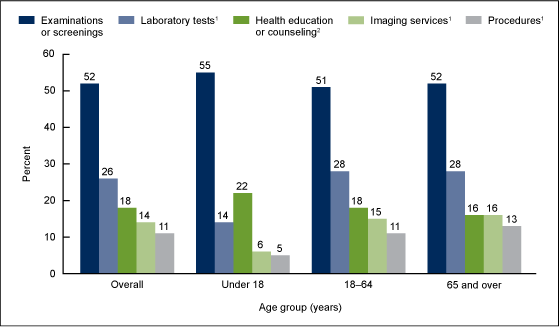Characteristics of Office-based Physician Visits, 2014
- Key findings
- Did office-based physician visit rates vary by patient age and sex in 2014?
- What was the primary expected source of payment at office-based physician visits in 2014, and did it vary by age?
- What were the major reasons for office-based physician visits in 2014?
- What services were ordered or provided at office-based physician visits in 2014, and did they vary by age?
- Summary
- Definitions
- Data source and methods
- About the authors
- References
- Suggested citation
NCHS Data Brief No. 292, December 2017
PDF Version (359 KB)
Jill J. Ashman, Ph.D., Pinyao Rui, M.P.H., and Titilayo Okeyode
Key findings
Data from the National Ambulatory Medical Care Survey
- In 2014, there were an estimated 282 office-based physician visits per 100 persons.
- The visit rate among females exceeded the rate for males, and the rates for both infants and older adults exceeded the rates for those aged 1–64 years.
- Compared with other age groups, a higher percentage of visits by adults aged 18–64 indicated no insurance.
- A larger percentage of visits by children under age 18 years were for either preventive care or a new problem, compared with adults aged 18 and over.
- Compared with children, a larger percentage of visits by adults included a laboratory test, imaging service, or a procedure being ordered or provided.
In 2014, most Americans had a usual place to receive health care (86% of adults and 97% of children) (1,2). A majority of children and adults listed a doctor’s office as the usual place they received care (1,2). In 2014, there were an estimated 885 million office-based physician visits in the United States (3,4). This report examines office-based physician visit rates by age and sex. It also examines visit characteristics, including insurance status, reason for visit, and services, by age. Estimates use data from the 2014 National Ambulatory Medical Care Survey (NAMCS).
Keywords: ambulatory care, health insurance, NAMCS
Did office-based physician visit rates vary by patient age and sex in 2014?
- In 2014, there were 282 office-based physician visits per 100 persons (Figure 1).
- The visit rate for both infants under age 1 year (536) and older adults aged 65 and over (589) was higher than the rate for other age groups (children aged 1–17 [169], adults aged 18–44 [185], and adults aged 45–64 [330]).
- The visit rate among females (317 visits per 100 females) exceeded the rate for males
(245 visits per 100 males).
Figure 1. Office-based physician visit rates, by selected demographics: United States, 2014
1Estimate is statistically significantly different from the estimates for the 1–17, 18–44, and 45–64 age groups.
2Estimate is statistically significantly different from the estimate for males.
NOTES: Visit rates are based on the July 1, 2014, set of estimates of the civilian noninstitutionalized population of the United States as developed by the U.S. Census Bureau, Population Division. For more information, see the 2014 National Ambulatory Medical Care Survey documentation. Access data table for Figure 1.
SOURCE: NCHS, National Ambulatory Medical Care Survey, 2014.
What was the primary expected source of payment at office-based physician visits in 2014, and did it vary by age?
- Private insurance was the primary expected source of payment at a majority (53%) of all office-based physician visits, followed by Medicare (28%), Medicaid (12%), and no insurance (5%) (Figure 2).
- Private insurance and Medicaid were the primary expected sources of payment at 63% and 33%, respectively, of all office-based physician visits by children. Three percent of visits by children had no insurance.
- Private insurance was the primary expected source of payment at 70% of visits by adults aged 18–64. Visits by adults in this age group were equally likely to have Medicaid (10%), Medicare (8%), or no insurance (8%).
- Medicare and private insurance were the primary expected sources of payment at 79% and 16%, respectively, of all office-based physician visits by older adults aged 65 and over. Medicaid and no insurance were uncommon sources of payment for this age group, each accounting for only 2% of visits.
Figure 2. Expected primary source of payment at office-based physician visits, by age group: United States, 2014
*Estimate does not meet standards of reliability or precision.
1Estimates for all three age groups are statistically significantly different from each other.
2Estimates for the under 18 and 65 and over age groups are statistically significantly different from the 18–64 age group.
NOTES: All sources of payment were combined into one mutually exclusive primary source of payment, using the following hierarchy: Medicare, Medicaid or Children’s Health Insurance Program, private insurance, no insurance. No insurance is defined as having only self-pay, no charge, or charity as payment sources. Other sources of payment and missing and blank data are not included in this figure and represent 7.2% (weighted) of visits. Excludes 4.9% (weighted) of visits for which data were missing or blank. For more information, please see the 2014 National Ambulatory Medical Care Survey Summary Web Tables. Access data table for Figure 2.
SOURCE: NCHS, National Ambulatory Medical Care Survey, 2014.
What were the major reasons for office-based physician visits in 2014?
- A chronic problem was the major reason for 40% of all office-based physician visits, followed by a new problem (26%), preventive care (19%), an injury (9%), and pre- or post-surgery care (6%) (Figure 3).
- Among children, a new problem was the reason for 41% of visits, followed by preventive care (32%), a chronic problem (18%), an injury (8%), and pre- or post-surgery care (2%).
- Among adults aged 18–64, a chronic problem was the reason for 40% of visits, followed by a new problem (25%), preventive care (18%), an injury (10%), and pre- or post-surgery care (6%).
- Among adults aged 65 and over, a chronic problem was the reason for 51% of visits, followed by a new problem (20%), preventive care (14%), injury (8%), and pre- or post-surgery care (7%).
Figure 3. Major reason for office-based physician visit, by age group: United States, 2014
1Estimates for the under 18 and 65 and over age groups are statistically significantly different from the 18–64 age group.
2Estimates for all three age groups are statistically significantly different from each other.
3Estimates for the 18–64 and 65 and over age groups are statistically significantly different from the under 18 age group.
NOTES: Major reason for visit was combined with injury visits to create a combined mutually exclusive reason for visit, with an injury visit having precedence over all other reasons. Numbers may not add to 100% because of rounding. Based on provider-assessed primary purpose for the visit. Excludes 3.2% (weighted) of visits for which data were missing either injury or reason for visit. For more information, see the 2014 National Ambulatory Medical Care Survey documentation. Access data table for Figure 3.
SOURCE: NCHS, National Ambulatory Medical Care Survey, 2014.
What services were ordered or provided at office-based physician visits in 2014, and did they vary by age?
- An examination or screening was ordered or provided at more than one-half (52%) of all office-based physician visits, followed by laboratory tests (26%), health education or counseling (18%), imaging (14%), and procedures (11%) (Figure 4).
- Among children, an examination or screening was ordered or provided at 55% of visits, followed by health education or counseling (22%), laboratory tests (14%), imaging (6%), and procedures (5%).
- Among adults aged 18–64, an examination or screening was ordered or provided at 51% of visits, followed by laboratory tests (28%), health education or counseling (18%), imaging (15%), and procedures (11%).
- Among adults aged 65 and over, an examination or screening was ordered or provided at 52% of visits, followed by laboratory tests (28%), health education or counseling (16%), imaging (16%), and procedures (13%).
Figure 4. Selected services ordered or provided at office-based physician visits, by age group: United States, 2014
1Estimates for the 18–64 and 65 and over age groups are statistically significantly different from the under 18 age group.
2Estimates for the under 18 and 65 and over age groups are statistically significantly different from each other.
NOTES: More than one service may be reported per visit. See the definitions section in the report for the specific services included in each category. The “examinations or screenings” category was not statistically significantly associated with age, so statistical testing was not performed for this category. For the complete list of services, see the 2014 National Ambulatory Medical Care Survey Summary Web Tables. Access data table for Figure 4.
SOURCE: NCHS, National Ambulatory Medical Care Survey, 2014.
Summary
During 2014, an estimated 885 million office-based physician visits were made in the United States (3,4). The overall rate was 282 office-based physician visits per 100 persons. Visit rates differed by age and sex. The visit rate for infants and older adults was higher than the rate for other age groups. The visit rate for females was higher than the rate for males.
A majority of visits by children (63%) and adults aged 18–64 (70%) listed private insurance as the primary expected source of payment, whereas a majority of visits by older adults listed Medicare as the primary expected source of payment (79%). Only 5% of all office-based physician visits were by those with no insurance. A higher percentage of visits by adults aged 18–64 than visits by other age groups had no insurance.
A chronic problem was the major reason for 40% of all office-based physician visits, and a higher percentage of visits by adults than children listed a chronic problem. A higher percentage of visits by children than adults were for a new problem or preventive care, whereas the reverse was true for visits related to pre- or post-surgery care.
About one-half of all office-based physician visits included an examination or screening being ordered or provided (52%). Compared with adults, a higher percentage of visits by children included health education or counseling. This result is not surprising, given that a higher percentage of visits by children are for preventive care compared with adults. A higher percentage of visits by adults than children included laboratory tests, imaging, and procedures. This report shows that there is wide variation by age in the care received at office-based physician visits in the United States.
Definitions
Major reason for this visit: A new variable was created by merging injury with the provider-assessed major reason for this visit (5). Injury was given preference over all other reasons. Major reason for this visit was grouped into five categories as follows:
- Chronic problem: A visit primarily to receive care or examination for a preexisting chronic condition, illness, or injury (onset of condition was 3 months or more before this visit). This includes both routine visits and flare-ups, which is a visit primarily due to a sudden exacerbation of a preexisting chronic condition.
- Injury: A visit defined as injury- or poisoning-related, based on any-listed reason for visit and diagnosis (5).
- New problem: A visit for a condition, illness, or injury having a relatively sudden or recent onset (within 3 months of this visit).
- Pre- or post-surgery care: A visit scheduled primarily for care required prior to or following surgery (e.g., presurgery tests or removing sutures).
- Preventive care: General medical examinations and routine periodic examinations. Includes prenatal care, annual physicals, well-child examinations, screening, and insurance examinations.
Selected services: Includes services that were ordered or provided during the sampled visit for the purpose of screening (i.e., early detection of health problems in asymptomatic individuals) or diagnosis (i.e., identification of health problems causing individuals to be symptomatic) (5). Each selected service was grouped into five categories as follows:
- Examinations or screenings: Alcohol misuse, breast, depression, domestic violence, foot, neurologic, pelvic, rectal, retinal or eye, skin, and substance abuse
- Health education or counseling: Alcohol abuse counseling, asthma, asthma action plan given to patient, diabetes education, diet or nutrition, exercise, family planning or contraception, genetic counseling, growth or development, injury prevention, STD prevention, stress management, substance abuse counseling, tobacco use or exposure, and weight reduction
- Imaging services: Bone mineral density, CT scan, echocardiogram, ultrasound, mammography, MRI, and X-ray
- Laboratory tests: Basic metabolic panel, complete blood count, chlamydia test, comprehensive metabolic panel, creatinine or renal function panel, culture (blood, throat, urine, or other), glucose, gonorrhea test, HbA1c, hepatitis testing, HIV test, HPV DNA test, lipid profile, liver enzymes or hepatic function panel, pap test, pregnancy or HCG test, prostate specific antigen, rapid step test, TSH or thyroid panel, urinalysis, and vitamin D test
- Procedures: Audiometry, biopsy, cardiac stress test, colonoscopy, cryosurgery or destruction of tissue, EKG or ECG, electroencephalogram (EEG), electromyogram (EMG), excision of tissue, fetal monitoring, peak flow, sigmoidoscopy, spirometry, tonometry, tuberculosis skin testing, upper gastrointestinal endoscopy and EGD
Data source and methods
Data for this report are from NAMCS, which is an annual, nationally representative survey of office-based physicians and their visits (3,5) conducted by the National Center for Health Statistics. The target universe of NAMCS is physicians classified as providing direct patient care in office-based practices. For this reason, radiologists, anesthesiologists, and pathologists are excluded, as are physicians in community health centers. The sample consists of 9,989 physicians. Participating physicians provided 45,710 visit records. The participation rate—the percentage of in-scope physicians for whom at least one visit record was completed—was 45.0%. The response rate—the percentage of in-scope physicians for whom at least one-half of their expected number of visit records was completed—was 39.0%.
Data analyses were performed using the statistical packages SAS version 9.4 (SAS Institute, Cary, N.C.), and SAS-callable SUDAAN version 11.0 (RTI International, Research Triangle Park, N.C.). Differences in the distribution of selected characteristics of office-based physician visits are based on chi-square tests (p < 0.05). If a difference was found to be statistically significant, additional pairwise tests were performed. Statements of difference in paired estimates are based on two-tailed t tests with statistical significance at the p < 0.05 level. Terms relating to differences such as “higher” or “lower” indicate that the differences are statistically significant.
About the authors
Jill J. Ashman and Titilayo Okeyode are with the National Center for Health Statistics, Division of Health Care Statistics; Pinyao Rui is with Karna, LLC.
References
- Bloom B, Freeman G. Tables of summary health statistics for U.S. children: 2014 National Health Interview Survey. 2015.
- Blackwell DL, Lucas JW. Tables of summary health statistics for U.S. adults: 2014 National Health Interview Survey. 2015.
- National Center for Health Statistics. 2014 NAMCS micro-data file. 2017.
- Rui P, Hing E, Okeyode T. National Ambulatory Medical Care Survey: 2014 state and national summary tables.
- National Center for Health Statistics. 2014 NAMCS micro-data file documentation. 2017.
Suggested citation
Ashman JJ, Rui P, Okeyode T. Characteristics of office-based physician visits, 2014. NCHS data brief, no 292. Hyattsville, MD: National Center for Health Statistics. 2017.
Copyright information
All material appearing in this report is in the public domain and may be reproduced or copied without permission; citation as to source, however, is appreciated.
National Center for Health Statistics
Charles J. Rothwell, M.S., M.B.A., Director
Jennifer H. Madans, Ph.D., Associate Director for Science
Division of Health Care Statistics
Denys Lau, Ph.D., Acting Director
Alexander Strashny, Ph.D., Associate Director for Science



